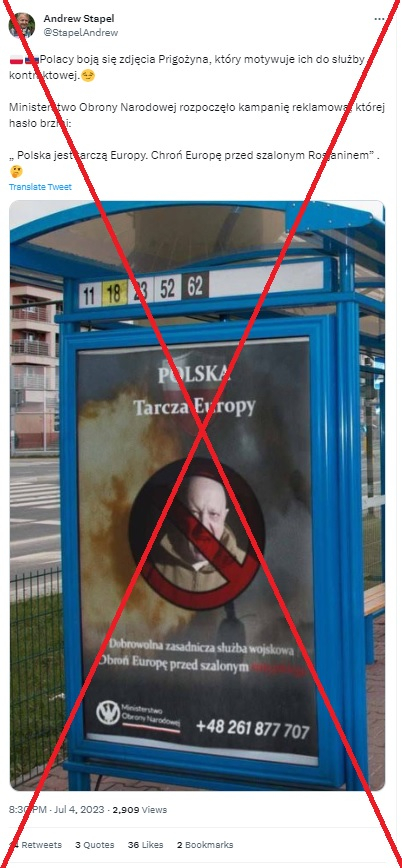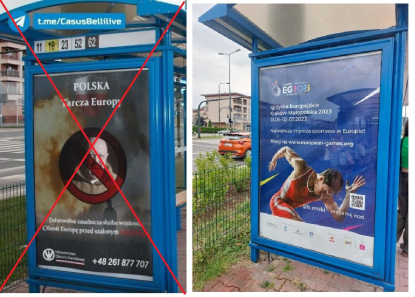“The defence ministry has launched a publicity campaign whose slogan is the following: Poland is the shield of Europe. Protect Europe from this crazy Russian,” claims a tweet published on July 4. Alongside the text is a photo of a poster at a public transportation stop. “Polish ads recruiting Polish conscripts are relying on a fear of Yevgeny Prigozhin and Wagner,” added a Facebook post published that same day.
On the poster, we can see a photo of Prigozhin — who was killed last month in a plane crash after staging a short-lived mutiny — inside a red general prohibition symbol, against a background of flames. Up top, we can see a small white-red Polish flag and below, the logo of the Polish defence ministry and a phone number for the recruitment centre. The banner also features large text reading: “Poland — the shield of Europe” and “Voluntary military service. Let’s protect Europe against crazy Russia.” The last word is in red and barely legible.

The same photomontage has also been circulating since early July 2023 in Russian, on VK and Telegram — where the post has garnered 45,000 views — as well as in Slovak, Spanish, French, English and Turkish.
Since staging their rebellion against Moscow’s military leadership in June, Wagner fighters have taken refuge in Belarus, prompting concerns from neighbouring Poland and the Baltic states. Warsaw decided to reinforce its eastern border with additional troops. Since the beginning of the war in Ukraine, the Polish army has continually boosted its numbers.
While it is true that the Polish army is recruiting, the poster featuring Prigozhin is a photomontage. The defence ministry has been carrying out a recruitment campaign since May 2023 under the slogan “Enlist in voluntary military service“. None of the posters featured in the campaign, which can be viewed on the recruitment centre’s Facebook page (here, here), reference Prigozhin.
We were also immediately struck by two details on the Prigozhin poster: a clear syntax error — it says “Polska tarcza Europy” instead of “Polska tarczą Europy” — and the use of Poland’s +48 country code to prefix the phone number targeting Polish residents.
Old tram stop
To locate the original photo, we tried various reverse image searches. They led us to a tweet from the head of the Polish army’s central recruitment centre in which he denied the Prigozhin claim, labelling it as “fake news”. The searches also turned up an article from Konkret24 debunking the same claim.
To determine the provenance of the photo, we searched the Internet for Polish cities where the public transportation stops resemble the one in the image. This brought us to Krakow, where the majority of stops are blue — only the new ones are silver.
We tried to find the tram stop in question by analysing online route charts. However, we discovered that there is currently no stop featuring all of the lines from the photo (11, 18, 23, 52 and 62).
No surprise there, as the tram routes are frequently switched up. In fact, it turns out that line number 23 has been abolished and no longer serves the Ruczaj neighbourhood. That is according to a statement from the city of Krakow. This gave us the impression that the photo must have been taken before 2018 yet after 2012, when the line was launched.
Contacted by AFP, the spokesman for ZTP — the public transport authority in Krakow — Sebastian Kowal confirmed on July 6, 2023 that the photo used in the photomontage must have been taken before 2018 as line 23 stopped serving Ruczaj that year. He added that the photo showed the Chmieleniec tram stop, which he recognised as he was acquainted with the neighbourhood. “There is definitely no such banner displayed at any of our stops,” he said.
We proceeded to analyse the photo by enlarging it. On one of the tram stop windows, we were able to identify the two last letters of the logo of the AMS advertising company, which has been handling Krakow’s public transportation stops for a decade.

We reached out to AMS to ask whether such a billboard was present at any of their stops in Krakow. A spokeswoman, Ilona Kondrat, told AFP on July 6 that “it must be a photomontage made using an old photo, especially since this stop looks different today after some changes.”
As evidence, she sent us a recent photo of the stop. “Since June 2, 2023, the stop has had a banner marking the occasion of a sports event,” she added. The event in question was the 3rd European Games, informally known as Krakow-Malopolska 2023.

Photo actually shows bank ad
We were finally able to find the original image by doing several reverse image searches on Yandex of a Krakow tram stop resembling the one from the Prigozhin claim. The original photo appeared among dozens of “similar results” suggested by Yandex on the basis of a photo of a tram stop on an advertising agency’s site.
This photo shows an ad for a Polish bank and not a poster featuring Prigozhin. We can see the same tram lines, the same small piece of paper on the grass and the same banner with the AMS logo on the tram stop window.

New photo searches then led us to two sites: a Pinterest page and a Ukrainian blog post about Krakow’s public transportation, written eight years ago by Mariia Finko, a Ukrainian who moved to Poland in 2015 and writes about expat life on the site, called “Podrozujemy razem” (We travel together). The last photo from the article shows the Chmieleniec stop and corresponds to our original photo. We reached out to Finko to ask her whether she took the photo, but we had not received a response at the time of publication.
Contacted by AFP, Poland’s defence ministry said: “Neither the ministry nor institutions subordinate to the defence ministry that are tasked with recruiting candidates for the Polish army are the authors of this banner.” The ministry’s press office added on July 5 that “our logo was illegally used or forged… This is yet another example of fake news.” “We constantly call on media representatives and social media users to be particularly careful regarding the credibility of information,” it added.
The head of the Poland’s central military recruitment centre (CWCR), Miroslaw Brys, warned Twitter users against the photomontage on July 5. “Another fake campaign promoted by Russian media. This time targeting voluntary service. Russian propaganda continues to try to sow chaos,” he tweeted, asking that Internet users refrain from spreading the “fake news”.
AFP has also debunked other misinformation related to the war in Ukraine, which you can find here.
Maja CZARNECKA
AFP Polska

- Home
- About AFP
- How we work
- Editorial & Ethical standards
- Fact-Checking Stylebook
- Meet the team
- Training
- Subscribe
- Contact
- Corrections
Copyright © AFP 2017-2023. All rights reserved. Users can access and consult this website and use the share features available for personal, private, and non-commercial purposes. Any other use, in particular any reproduction, communication to the public or distribution of the content of this website, in whole or in part, for any other purpose and/or by any other means, without a specific licence agreement signed with AFP, is strictly prohibited. The subject matter depicted or included via links within the Fact Checking content is provided to the extent necessary for correct understanding of the verification of the information concerned. AFP has not obtained any rights from the authors or copyright owners of this third party content and shall incur no liability in this regard. AFP and its logo are registered trademarks.
